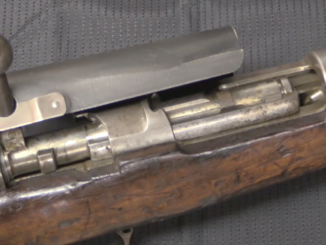The Portative was an attempt by the Hotchkiss company to make a light machine gun companion to their heavy model (which had found significant commercial success). The Portative used the same feed strips, albeit loaded upside down, and the same gas piston operation, but a very different locking system. Instead of a tiling locking block the Portative had a “fermeture nut” that rotated to lock onto the bolt with three sets of interrupted thread locking lugs. In addition, many of the traditionally internal parts were mounted externally on the Portative, and it was quite the awkward gun to use.
The Portative was adopted by the American Army as the Model 1909 Benet-Mercié, and by the British early in World War One as a cavalry and tank-mounted gun. The remainder of Portative contracts were relatively small from second-tier military forces, including several South American countries.




though it’s not always possible with these rarer weapons, I love these big breakdown videos. it’s always so much more helpful seeing individual pieces move to understand how things work.
Your description of the operational design shortcomings can be viewed as the lack of real practical experience with machine gun design for optimum usability by the various militaries. Every company conducting development work was trying to find total reliability and working with the best ideas they could develop. As an experienced machinist, my hat is off to the people who had to make all those intricate cuts work together.
Three things.
Even if the Madsen was arguably a better weapon at that time, the Hotchkiss is the design that evolved in the modern LMG gas actions. The Madsen was a more perfected weapon, but an evolutionary dead end.
In 1896, Hotchkiss patented BOTH the strip feeding and the metallic belt feeding. They offered the metallic belt option for much of their products, but without much success. Strip feeding (or a variant largely used in WWI, three rounds strips hinged together to form a belt of any length) had been the favored method of almost any purchaser until the expiration of the patent.
Probably because it was, even if only slightly, more reliable.
(if someone wonder the reason for the weird magazine feeding of the Fiat Revelli 1914, this is one. The other two ways of “push through” feeding, were patented already).
A weak point I can see of the action is the strip pulling device. A similar one made to convert the BREN to belt feeding failed miserably. Being the feeding pawl a longer lever than the ones actuated by the bolt carrier, the geometry of the lever is unfavorable. This is not much of a problem for strip feeding, but it would be with the higher resistance of belt feeding.
“(…)quite the awkward gun to use.(…)”
According to https://modernfirearms.net/en/machineguns/great-britain-machineguns/hotchkiss-portable-mk-i-eng/
The cocking handle is made as a separate unit, and projects from the rear of the receiver. It does not reciprocate when the gun is fired and, furthermore, its rotation controls the mode of fire, that is, semi-automatic or full-automatic mode.
why they elected to hide fire selector inside cocking handle? Did any other fire-arm design worked that way?
apropos of all things important.
Not to be pedantic, but although the inventor’s name, John Garand, is pronounced so it rhymes with “errand,” when applied to the rifle, the name was pronounced so it rhymes with “grand” all throughout the military–by the soldiers, in training films, and so on–and up until fairly recently even among all civilians. Thus, when referring to the rifle, it is Garand like “grand”.
Wait… was not we already settled that down at https://www.forgottenweapons.com/garand-pronunciation/ ?
The amazing thing is just how long it took for people to figure out and distill down what an LMG should be, in terms of handling and so forth.
I suspect that the guys down at the coalface could have articulated what they needed, but nobody bothered to ask them. The brass then, as now, was in the mindset that the troops could not possibly know anything useful, and it was all top-down driven. Someone who watched machine guns in action talked to the designers, and they tried to satisfy the needs that they articulated. Nobody went out and interviewed the troops, or got the feedback from the crews on things like maintenance and ergonomics. Nobody did any “time-and-motion” studies or any real research into crew dynamics.
Except the Germans.
If you look at the successful MG systems that came along after WWI, the thing that leaps out at you is that the majority of those developments came out of circumstances where the designers were working with actual veterans, like the way the Germans ran the program that eventually turned out the MG34/42 family of guns.
The other interesting thing is how the more eclectic the program was, the better… The Germans had zero issues bringing the DISA tripod designed for the Madsen into general issue as the Lafette tripod. Everyone else? Wanted their own designs, even at the expense of flexibility. To this day, the US is still sticking the same tripod they issued for the M1919 series of guns under their GPMG, which makes very little sense.
There is an article about this gun in the American Rifleman for September 2010. It reproduces contemporary photos of the gun in operation. The US army of the time seems to have had the same problem with the flimsy bipod, and so used a long strap attached to the bipod legs and run through the trigger guard. This will have enabled the gunner to pull back against the bipod.
The article states that the US named the gun the Benet Mercie after two Hotchkiss employees who had worked on it. Why they did this is not explained. It seems rather unusual.
It also relates that a contemporary firearms expert called Edward C Crossman stated that when he tested a Benet Mercie at the Colt factory, the gun broke six parts in the first 20 rounds, including the firing pin and extractor. He put this down to the day being very cold, but that should hardly affect steel components, and the firing pin on the piece looks robust. I wonder if the manufacturing process was defective? I have no reason to doubt his story.
Given that this was on of the first LMGs I feel we must cut it some slack. Early guns like this were pioneers, and the Hotchkiss seems to have worked well in trained hands. It certainly seems to have been a good tank machine gun for the British army.
“(…)Why they did this is not explained(…)”
https://www.findagrave.com/memorial/35669155/laurence-vincent-benet claims that first of them was internationally known engineer and inventor of refinements and improvements to the Hotchkiss Machine Gun. Interestingly
Interviewed after his retirement, Mr. Benet smiled and said, “I believe I have been called a ‘merchant of death,’ Do I look it?” “I’m sorry,” he added, “that my fingers are not dripping blood this morning.”
His profession, he said, did not fill him with horror. “One of the great satisfactions of my life,” he went on, “is that the Hotchkiss machine guns saved Paris from the Germans. Most of the liberties we enjoy were won by the sword. If people have nothing else to fight with they will fight with their hands/”
I think you’ll find that the portative was chosen for all Empire cavalry as war seemed reasonably likely.
The Australian Light Horse didn’t have to wait for their Portatives, once they got to Nth Africa.
Britain was just never that DUMB!
The Australian Light Horse managed to do quite well, with the Portative.
I have read almost all the available accounts of their WW1 campaigns. And they didn’t complain about it much, at all.
IME our soldiers just get on with it and learn how to manage around deficiencies in equipment. Some LH Reg’ts saw service in France as well, and they didn’t bitch about it, either!!